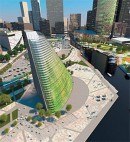CO2 for the Greenhouse

Swedish firm Plantagon broke ground last week on the first vertical greenhouse in the city of Linkoping. The slanting structure was designed by Sweco, and is hoped to be the first in a series of similar volumes across the world. The Plantagon Greenhouse project is an initiative to provide sustainable solutions to farming in urban environments and offers a viable alternative for the use of excess heating and CO2 from nearby industries. Behind the magnificent glittering greenhouse is a theory that transportation costs will be cut by delivering the produce directly to the end users in urban areas, also reducing environmental damage. Plantagon found funding through the Swedish Government’s cleantech initiative, the Delegation for Sustainable Cities in January 2011, with Hans Hassle, CEO of Plantagon International AB admitting his shock at securing the funding so close to home: “It comes as a bit of a happy surprise, as we have travelled around the world to several cities that have shown interest in our concept, and we end up starting it right here, in the Stockholm area.” A number of green, leafy vegetables will be grown within the crystalline shell, including White Celery Mustard, Kailaan, Osaka Purple and Oriental Saladini, as these species do not need to be harvested subsequently and therefore do not have to be bound or placed in a darkened environment for planting. A variety of alternative designs have also been proposed for other locations across the world including a spherical option. This globe encases a spiralling helix which acts as a transport mechanism moving soil-filled planting boxes upwards as the plants flourish. At the summit, the mature plants are transported to a harvesting platform to make space for younger plants to join the line at the base. The building’s spherical form maximises the potential light infiltration however Plantagon admits that this has caused costs to rise. They explain: “The unusual form adds to construction expenses, but we say that the doubling or even tripling of yields, makes the structure more than competitive with traditional greenhouses or surface agriculture. With a ground footprint of 10,000 sq m, a vertical greenhouse equals 100,000 sq. m of cultivated land.”
SWECO architects AB


